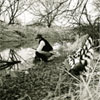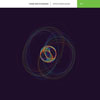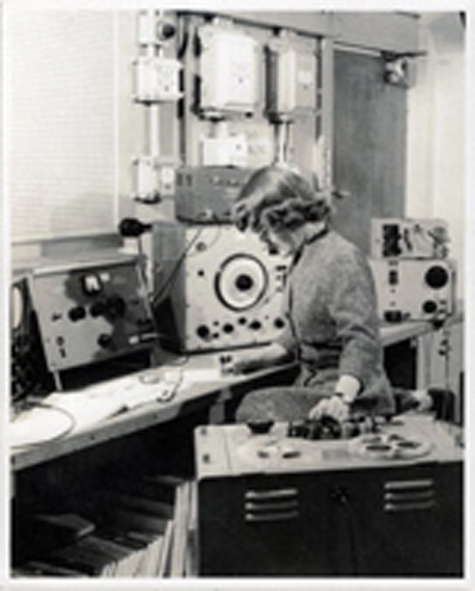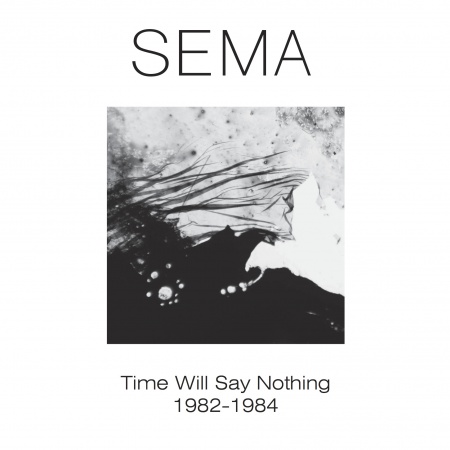- Administrator
- Albums and Singles
 An enigmatic project out of the wilds of Madison, Wisconsin, this duo, with connections to the likes of Kinit Her, Burial Hex, and many more projects, weave together an unlikely combination of medieval folk, post-rock, and electronic sounds into two side-long pieces that channel a variety of moods, though most of them are cast with some level of darkness.
An enigmatic project out of the wilds of Madison, Wisconsin, this duo, with connections to the likes of Kinit Her, Burial Hex, and many more projects, weave together an unlikely combination of medieval folk, post-rock, and electronic sounds into two side-long pieces that channel a variety of moods, though most of them are cast with some level of darkness.
The A side of this vinyl, "Helix I," is where the medieval vibe comes through most.Through twisted strings, deep cello and trumpet fanfares, there is a sense of time long past emanating throughout, but devoid of any renaissance fair type clichés.Attention is eventually drawn towards passages of guitar, with the strings sinking back into a droning, bleak backing track.The individual instruments meld together into a cold wall of sonic abstraction, becoming more and more pensive as the piece concludes.
The flip side, "Helix II," picks up with unidentifiable sound sources creating a ghostly fog of sound.The occasional higher register note occasionally pierces through the mostly bass heavy drone, but only to be pulled in again.With the appearance of distant, marching rhythms a dramatic flair definitely can be heard, reaching a restrained peak of bombast before pulling back.
Mostly naked, strummed guitar chords fill up this space, with field recordings of thunderstorms and distant trumpets keeping everything rather bleak.Surprisingly, what sounds like an electric guitar kicks in, giving a distinctly modern feel to the song, especially when compared to the other side.The addition of a repeating, percussive pulse is where things start to feel more conventional, but in a good way.
With one half feeling like a bizarre take on medieval folk sounds, and the other bringing up bits of new wave rhythm and synth, Yesodic Helices could be a directionless mess, but the end product is anything but.Drastically different sounds and moods abound, but they all come together in a beautiful, if dark and murky, pair of ghostly long-form pieces that transcend genre labels.
samples:
 
Read More
- Administrator
- Albums and Singles
 The subharcord is an early electronic instrument designed in East Germany during the 1960s. Essentially a subharmonic sound generator, its main function was to be a sound effects generator for TV and film. Only three of the original eight machines are thought to exist, and Bretschneider used one of them in June of 2007 (later remixed and edited in 2011) to create the material that makes up this single piece, a multifaceted composition that stays compelling throughout its entire 37-minute duration.
The subharcord is an early electronic instrument designed in East Germany during the 1960s. Essentially a subharmonic sound generator, its main function was to be a sound effects generator for TV and film. Only three of the original eight machines are thought to exist, and Bretschneider used one of them in June of 2007 (later remixed and edited in 2011) to create the material that makes up this single piece, a multifaceted composition that stays compelling throughout its entire 37-minute duration.
A single piece broken into eight logical segments, Kippschwingungen works as a long-form composition as well as in smaller, track-sized bites, something that is rare in this world of sound art.It does not require to be heard in full, nor does it sink off into the background if attention is not focused solely on it.
The short opening passage, a monochromatic outburst of wet motor noise panning from side to side, sets the stage for what comes.The following part adds sweeping layers of nasal electronic sound, slowly building into what sounds more like the work of a traditional synthesizer.Slowly but surely a layer of dry clicks and pops arise, balanced precariously between glitches and true rhythmic structures.
These clicks become a dominant motif through the next few movements, an almost jarring outburst that sounds like an over-amplified needle piercing cloth.What sounds like began life as static eventually becomes a full-fledged rhythm, locking into an identifiable structure as a quiet layer of ambient electronics surrounds it.These proto-beats get deeper and rawer, becoming an approximation of a 909 kick drum thump that is panned from side to side.
The textures shift from identifiable rhythms to a jackhammer-like outburst of noise. While it is a thin, brittle sound, the subharcord shows that it was capable of serving its original, sound effect generating purpose.Eventually the repeated pulses slow down, breaking apart like an overworked engine.
The final three segments wander in a more abrasive direction, with the rhythmic throb resembling a helicopter being subjected to an array of processing and effects, staying static but evolving at the same time.Finally the piece comes to its conclusion first as a rapid fire, disorienting blast of sound and then finally a roaring, raw sine wave.
Kippschwingungen is definitely a concept album, but one that manages to cross-over from the often stoic, academic world of sound art and into an abstract, yet memorable piece of electronic music.With the admittedly odd uses of rhythms and textures, there becomes a certain sense of, for lack of a better term, catchiness that comes out.It is this that makes Bretschneider's album stand out amidst a crowd of similar, but less compelling practitioners.
samples:
 
Read More
- Administrator
- Albums and Singles
 Originally released to raise money for recording the next Swans studio album, this live album has been repackaged and trimmed down for mass consumption. Capturing the group at one of its many peaks, it provides a thrilling document for those who paid witness or for those poor unfortunates who found themselves unable to attend any of the shows. A wide range of older classics, recent songs and new semi-improvised works make up the set list. If anyone still doubted the sincerity or legitimacy of the reformed Swans, this will silence all arguments.
Originally released to raise money for recording the next Swans studio album, this live album has been repackaged and trimmed down for mass consumption. Capturing the group at one of its many peaks, it provides a thrilling document for those who paid witness or for those poor unfortunates who found themselves unable to attend any of the shows. A wide range of older classics, recent songs and new semi-improvised works make up the set list. If anyone still doubted the sincerity or legitimacy of the reformed Swans, this will silence all arguments.
Beginning with "No Words No Thoughts" from the mighty "comeback" album My Father Will Guide Me Up a Rope to the Sky, it is easy to hear how the already lengthy intro segment had elongated and mutated into a piece of its own. The album plays for about 15 minutes before "No Words No Thoughts" actually kicks in properly and already the mood is white hot. Swans have always been able to transport me and this is no exception as I am dropped back into that same head space as I was on the 22nd of October last year.
Slowing their pace, the group move through a stunning rendition of "Jim" (where Christoph Hahn’s slide guitar almost brings me to my knees) before unleashing a monster in the form of "Beautiful Child." The twin percussion of Phil Puleo and Thor Harris drive the song on with a ferocity that should be hard to match but the rest of the group follow them, matching them beat for beat and sweat and for sweat. Michael Gira’s voice sounds a bit rough here and throughout the album, undoubtedly due to the strain of giving it his all every night. However, while this should result in a flawed listening experience, it adds to the frantic feeling running through the performance. Other older songs get an airing but it is this and the "Sex God Sex" which stand out in terms of intensity.
This brings me to the new songs, the ones that I was most excited about hearing when these discs landed. All are embryonic jams here (Gira’s commentary on the demo recordings from the first edition suggest that much of the new material on the live album has been reworked or added to) but they show that the spark that ignited the new incarnation of Swans is far from extinguished. Two of the new pieces are tacked on to the beginning of older songs; "The Seer" explodes into "I Crawled," whereas the scorching riot of "93 Ave. B Blues" suddenly drops out into the tender "Little Mouth." Gira still knows how to confound expectations. Unfortunately, one of the new songs played on the tour, "Avatar," was left off the album (though it will be on the next studio album judging from what Gira has been saying).
The centerpiece of We Rose from Our Bed with the Sun in Our Head is "The Apostate," a stand-alone piece which is truly immense (it kept getting bigger and bigger as the tour went on and here it clocks in at just under 17 minutes). Starting like a bastard sibling of the B-side of Einstürzende Neubauten’s album Fuenf auf der nach oben offenen Richterskala before nearly launching off into space, I am sorry that the Dublin gig was not at the end of the tour so I could have heard this in the flesh. As Gira ad libs the lyrics over an evolving and complex backing, it is hard not to stop what I am doing and stare dumbfounded at the stereo’s display. If the new album has even a quarter of this power, I will be ecstatic.
Since I received the first edition of this album some months ago, I have played the crap out of it. To me, it is up there with Swans Are Dead and Public Castration Is a Good Idea, forming a holy trinity of live albums (and to me, the definitive Swans sound). It is great to see this getting an airing beyond those who were lucky enough to be on the internet at the time of its original release. While the solo demo recordings for the new album have been left off this version, the meat is still here.
samples:
 
 
 
Read More
 Originally released to raise money for recording the next Swans studio album, this live album has been repackaged and trimmed down for mass consumption. Capturing the group at one of its many peaks, it provides a thrilling document for those who paid witness or for those poor unfortunates who found themselves unable to attend any of the shows. A wide range of older classics, recent songs and new semi-improvised works make up the set list. If anyone still doubted the sincerity or legitimacy of the reformed Swans, this will silence all arguments.
Originally released to raise money for recording the next Swans studio album, this live album has been repackaged and trimmed down for mass consumption. Capturing the group at one of its many peaks, it provides a thrilling document for those who paid witness or for those poor unfortunates who found themselves unable to attend any of the shows. A wide range of older classics, recent songs and new semi-improvised works make up the set list. If anyone still doubted the sincerity or legitimacy of the reformed Swans, this will silence all arguments.
- Administrator
- Albums and Singles
 Previously, Gregory Scharpen’s work as Thomas Carnacki has been strange in an unsettling way, finding haunted parts of the psyche and probing them relentlessly. For this latest album, the music retains its strangeness but now there is a fantastic, warm feeling running through the pieces. There remains a darkness lurking beneath the surface but Scharpen’s humor is more evident now than before.
Previously, Gregory Scharpen’s work as Thomas Carnacki has been strange in an unsettling way, finding haunted parts of the psyche and probing them relentlessly. For this latest album, the music retains its strangeness but now there is a fantastic, warm feeling running through the pieces. There remains a darkness lurking beneath the surface but Scharpen’s humor is more evident now than before.
 
Alethiometer Records
Inspired by Matmos’ album The Rose Has Teeth in the Mouth of a Beast, Scharpen created an album of pieces dedicated to friends and colleagues. The germ of this album can be found on the tribute compilation, Irreplaceable Hand, a fundraiser for Dax Pierson who was paralyzed in 2005. "Bedtime Story for the Most Fragrant Room in the Ward (for Dax)" from that album appears here and forms a poignant focal point for The Oar of Panmuphle. Bearing in mind that this is probably the oldest piece on the album, it sounds like classic Thomas Carnacki as indeterminate clicks, clacks, taps and rattles chatter over an intermittent metallic bowing.
As usual with Scharpen’s work, there are oblique and not-so-oblique references to Surrealism and decadent literature; indeed, the title of the album alludes to one of the characters in Alfred Jarry’s Exploits and Opinions of Dr. Faustroll, ‘Pataphysician. One of the best such bits comes early in the album with a dusty loop of Screamin’ Jay Hawkins’ "I Put a Spell on You" forming the backbone of "Death Dance of the Ant Queen (for Dawn)." The pure bad-ass rhythm and the original song’s pseudo-occult subject matter fit perfectly with Scharpen’s approach to music, especially as the sample begins to break down and recombine in unfamiliar patterns as Scharpen takes the everyday and shows us a hidden facet of it.
Elsewhere, it feels like Scharpen is doing the opposite by using commonplace references to obscure things; many of the pieces seem to use in-jokes or private references as starting points. There are a number of rather odd inclusions that do not entirely make sense to an outsider such as part of a lecture by Jon Ronson about his book The Men Who Stare at Goats on the aforementioned "Bedtime Story…" Undoubtedly the weirdest sample appears on "The Last Trip to Clown Town (for Matt)," a queasy vocal refrain by (presumably) a clown which probably raises a smile on Matt Waldron’s face but I find it perplexing and even alienating (it is definitely annoying!). Yet, as irritating as that particular sample is, the piece works terrifically well within the confines of this strange, strange album.
This personal approach to his music, or at the very least personalised approach, has opened up Scharpen’s music beyond the already vibrant forms it inhabited. Scharpen has hinted that there is at least another album of similar works in progress and I am interested to hear the results of further experiments as The Oar of Panmuphle is utterly beguiling.
samples:
- Bedtime Story for the Most Fragrant Room in the Ward (for Dax)
- The Last Trip to Clown Town (for Matt)
- Encoded for the One-Half, and Not the Many (for Kristin)
 
Read More
- Administrator
- Albums and Singles
 This debut release from Matt Harries as Brennendes Gehirn is a veritable storm of turbulent noises, ranging from freeform sketches to the kind of almost-danceable rhythms that I would expect from classic albums from Scorn. Bleakly psychedelic sounds reverberate and bump off each other like living creatures as Harries builds a magnificent range of pieces from the sort of junk sounds that can easily be boring or clichéd in less skilled hands.
This debut release from Matt Harries as Brennendes Gehirn is a veritable storm of turbulent noises, ranging from freeform sketches to the kind of almost-danceable rhythms that I would expect from classic albums from Scorn. Bleakly psychedelic sounds reverberate and bump off each other like living creatures as Harries builds a magnificent range of pieces from the sort of junk sounds that can easily be boring or clichéd in less skilled hands.
 
The curtains of noise that form "Chorea Imagnativa Aestimativa" hide a number of items from us. What are those strange voices saying? What is that haunting bell-like vibration? Where are we and is it safe? Harries drops us into a fog of pure sound and the disorientation created by the piece sets the tone for the rest of Epidemics of the Modern Age. Forms emerge from the haze, insectoid and disturbing. "Over Man and Beast His Flaming Sword" continues this apocalyptic cacophony, intensifying and distilling the music into sheets of glorious and almost painful noise.
Suddenly, Harries’ almost impenetrable wall of sound shatters on "Annihilation (Awakens New Life)" to reveal a soothing but slightly unnerving loop of strummed harp and percussion. The surprise use of melody and structure after the amorphous pieces that come earlier in the album reinforces the power of both approaches. While a whole album of in-the-red volume is always welcome, Harries has made something far stronger than just another noise album. He pushes further with "Elegie für Clemens Scheitz," which sounds like someone in an empty car park playing a Tricky album slowed down to an oily, grimy funk. Shimmers of feedback cut through the sluggish, bass-heavy rhythm as queer voices seem to emerge from the air. It is a terrific track to say the least.
Harries returns to a more harsh noise aesthetic for "Chorea Sancti Viti." The longest piece of the album delves into the depths excavated many years ago by Lustmord. I cannot say it is my favorite piece on Epidemics of the Modern Age but I much prefer it to most of that dark ambient malarkey that gets released, possibly because Harries does not allow it to remain too ambient and actively gets me by the ears and forces me to listen to his work. A metallic ringing, like the resonance of a huge drill, comes out of the speakers in waves. The shimmering sound creates a claustrophobic audio net and seems to get tighter and tighter as the piece progresses. It is a hell of a way to finish off, especially given the movement of some of the earlier pieces.
samples:
 
Read More
- Administrator
- Albums and Singles

Despite being one of the most visionary and iconoclastic artists to emerge from the early days of electronic music (as well as a rather fascinating and enigmatic person), Daphne Oram has only recently (and posthumously) begun to get the recognition she deserves.  Unlike the similarly wonderful and massive Oramics compilation from 2010, The Oram Tapes is comprised of largely unheard work from Daphne's mountainous tape archive that is currently being sifted through at Goldsmiths College.  That naturally means a tendency towards sketches and excepts, but it also means that it is sometimes alternately weirder, harsher, better, and more intimate than its predecessor.
Interestingly, Daphne is most famous for co-founding the BBC's Radiophonic Workshop, which used innovative technology and methods to create striking, otherworldly sound effects for shows like Dr. Who.  In fact, all of the pictures included in this release seem to be taken there, as they show Oram in a laboratory-esque environment surrounded by serious-looking men in suits.  Now here is the twist: Oram actually left both the BBC and financial stability behind in 1959 (less than a year after the Workshop was founded) due to her frustration with her employers' lack of understanding regarding her work's potential.  She set up her own studio in a hop kiln, surrounded herself with self-built and modified equipment, and quixotically managed to make a modest living making exactly the kind of strange and innovative music she wanted.  (Incidentally, my other favorite thing about Oram is an apocryphal story about how two of The Beatles visited her at her studio once and how she had absolutely no idea who they were, nor did she particularly care once she found out.)
Aside from indirectly providing sound effects for a show I despise and being super-humanly disinterested in pop culture, Daphne is also notable for being the first woman to ever design and build an electronic instrument: the Oramics machine, which converted drawings to sounds.  It is unclear how many of these recordings actually employ that technology, as she did not start using it to compose until 1968 and many of these recordings are undated.  Also, they all sound bizarre enough to have originated in any number of ways...and they did.  The most extreme example is probably her work for The Innocents, which is built from African field recordings.This is arguably the most extreme foray musically too, as the included excerpt culminates in an explosion of distorted and frightening animal howls (amusingly followed immediately by a very pleasant music box-like recording for a butter commercial).  Another commercial piece, "Anacin Components," unexpectedly turns out to be one of the album's most weirdly compelling moments, as it features Oram discussing how toothaches should sound in a very cheery and prim British way.
Aside from those rare glimpses into what Oram was actually like, my favorite pieces are the ones that still sound improbably contemporary.  "Illustrations," in particular, sounds like it could have easily emerged from the cassette underground last week (Oram unwittingly embraced tape hiss and analog synth textures way before they were cool).  Some of the other stand-out pieces are bit less musical though, as Daphne's murky and unsettling score for Hamlet sometimes sounds like a proto-Throbbing Gristle.  The Hamlet score is not a fluke either: despite her polite, square-seeming demeanor, she certainly did not shy away from catharsis, cacophony, ugliness, and industrial rumbles and shudders when it fit a piece.
There are also quite a few pieces of historical interest here, as The Oram Tapes features alternate versions and fragments of one of Daphne's major works, "Pulse Persephone."  Also, there are two pieces taken from tapes enigmatically labeled "2001," which may or may not have wound up in Kubrick's film.  That wasn't especially exciting for me (I was far more interested in finding out how toothaches sound), but it is certainly a notable inclusion.  Naturally, a double album of early electronic music (particularly one composed of mostly fragments) holds limited entertainment value for most people, as it is not an epoch that has aged particularly well.  However, as a history lesson and a portrait of a brilliant, complex, and uncompromising artist, this collection is pretty exceptional. The fact that some of the pieces still sound great is certainly nice, but being introduced to the artist eclipses the actual art (in a good way, of course).  While Oram's relative obscurity (until recently) makes it unlikely that she was a direct influence on many of today's artists, she certainly anticipated many elements of trends that hit decades later and did it on her own, in a very male-dominated milieu, and built her own goddamn instruments to do it.  If that is not inspiring, I do not know what is.
Samples:
 
Read More
- Administrator
- Albums and Singles
Special 5-CD box-set edition of the Broken Flag Retrospective originally released on vinyl in 2007. A compilation and retrospective of one of the most important and influential British noise and power electronics-labels led by Gary Mundy of Ramleh.
This edition was made to coincide with the Never Say When event organised by Second Layer and Harbinger Sound. Includes classic material spanning 1982-85 from Sutcliffe Jugend, Consumer Electronics, Un-Kommuniti, Maurizio Bianchi, Controlled Bleeding, Ramleh, Male Rape Group (Mundy/Best), Kleistwahr, TOLL, New Blockaders, Mauthausen Orchestra, Falx Cerebri, Giancarlo Toniutti, Vortex Campaign and many more. All material is the same as the out-of-print vinyl edition. Also comes with a booklet featuring extensive notes by Gary Mundy.
More information is available here.

Read More
- Administrator
- Albums and Singles
SEMA was an 80's experimental-project by Robert Haigh who became well-known in the '90s for his ambient Drum & Bass-project Omni Trio.
In 1980, Robert formed the industrial/avant-funk bands Truth Club and Fote as well as his own label Le Rey Records.
Between 1982 and 1984 he released 4 LPs under the name SEMA on his own Le Rey label: Notes from Underground, Theme from Hunger, Extract from Rosa Silber and Three Seasons Only - which can be found in this box set release.
He also contributed to several Nurse With Wound (United Dairies) projects. Those recordings are provided as bonus tracks on this box set in addition to the 4LPs.
The music of SEMA integrates pianos, orchestral instruments and experimental techniques in a neo-classical and minimalist approach.
These legendary recordings employ a wide palette of light and shade, emotion, texture and atmosphere to produce a sound that is unique in its form and expression.
More information is available here.

Read More
- Administrator
- Albums and Singles
Nad Spiro has a new album project out this month : Atomic Spy.
Released in a limited run of 101 copies, is the debut album on the new GaSaG
imprint within the GEOMETRIK RECORDS family with a focus on different
formats and unpublished gems.
Official distribution from www.GEOMETRIKRECORDS.com (launch date: 22 may)
Also via Bandcamp artist channel : listen to Atomic Spy >>
http://gasag.bandcamp.com
First copies will be available @ Arte-Oído festival in Madrid, 18 may (+
People Like Us) http://on.fb.me/KV40rh
- - - - - -
In Atomic Spy, Nad Spiro explores further her world of shadows and uncovers
hidden and twisted sounds, electronic spells that occupy your attention.
Her sound-fiction evokes secret accidents and carpark conspiracies, body
invasions and auditory hallucinations... like ghost transmissions and melodies
from a lost city.
The art work of the cd is by master of photomontage Josep Renau
(1907-1982), an image in tune with the Atomic Spy's Electricity Zone

Rosa Arruti has worked for many years under the alias NAD SPIRO -a solo
venture where complex processed guitars are built into a world of electronic
textures- and her recordings are released on the pioneer Spanish experimental label GEOMETRIK RECORDS .
Member of some of Barcelona's cult underground bands (Tendre Tembles, Mohochemie...) she has collaborated with other experimentalist as My Cat is an Alien or Kim Cascone.
www.spiro-mess-age.com
youtube http://bit.ly/Ka9Vax
Read More
- Administrator
- Albums and Singles
 The exquisitely curated 12k label has always had a diverse roster, but Gareth Dickson may be the most "out there" artist to be working with the label. In this case, it is because his acoustic guitar and vocal work is so much more along the lines of conventional singer-songwriter when placed aside the label's otherwise more electronic and abstract catalogue. However, Dickson's work has an understated complexity and depth that makes it a perfect fit for the label. And furthermore, this is another excellent work from this Scottish artist.
The exquisitely curated 12k label has always had a diverse roster, but Gareth Dickson may be the most "out there" artist to be working with the label. In this case, it is because his acoustic guitar and vocal work is so much more along the lines of conventional singer-songwriter when placed aside the label's otherwise more electronic and abstract catalogue. However, Dickson's work has an understated complexity and depth that makes it a perfect fit for the label. And furthermore, this is another excellent work from this Scottish artist.
At first, Dickson's work seems like standard acoustic folk music, though very well done.On the surface, it has shades of Nick Drake and Leonard Cohen, though the former more in vocals and the latter in actual guitar playing.On a song like "Snag With The Language," his rapid guitar plucking is reminiscent of Cohen’s first few albums, but the Glasgowian accented singing is distinctly different, coming across very Drake-like on the darker "The Hinge of the Year."
More attentive listening, however, reveals so many more layers to be heard, and expertly produced and mastered.The intimacy of opener "Two Halfs" (featuring Vashti Bunyan on both additional instrumentation and backing vocals) makes this immediately apparent.Other departures are more drastic:for example, his unexpected use of backing vocals (by Celine Brooks) on "The Big Lie" results in an even richer, more nuanced approach that features him doing quite a lot with intentionally little.
As someone whose appreciation for music of this style is mostly limited to the aforementioned Leonard Cohen, it is Dickson's subtle accents and treatments to the music that made this a captivating album for me.On the previously mentioned "Snag With the Language," he generates a great sense of space around the guitar, and there is a particularly impressive mood shift to an even darker sound as it goes on, a variation made all the more noticeable by a more rhythmic playing style and the introduction of actual percussion into the mix.
There is a greater sense of electronic instrumentation on instrumental "The Solid World," with Dickson creating an expansive ambient space, simultaneously understated and delicate.The electronics remain the focus, with the guitar acting in more of an accent capacity, but even with that somewhat drastic shift in style, the song fits in perfectly with the remainder of the album.
The album closes on a cover of Joy Division's "Atmosphere," which is a fitting choice given the original song’s blending of electronic and traditional elements, as well as a distinctly depressive mood.Dickson does not tinker with the formula too dramatically:his overall approach to music remains faithful to the original, but keeps the song from ending up in the cliché "acoustic cover of familiar song" bin of boredom by putting his own distinct stamp on it.
As someone who is very selective about what I like in this style of music, Orwell Court is an exemplary example of acoustic-centric music.The album speaks volumes as to his ability and adeptness in not only writing and performing songs, but his overall expertise in contributing greatly to a style that is so intentionally minimalist.The additional effects and instrumentation Gareth Dickson has employed here go a long way in fleshing out the sound, but never upsetting the delicate nature of the music, staying understated yet amazing from beginning to end.
samples:
 
Read More

